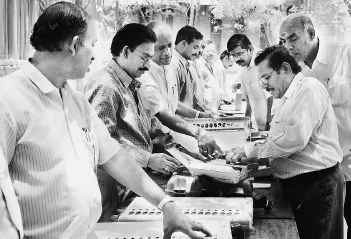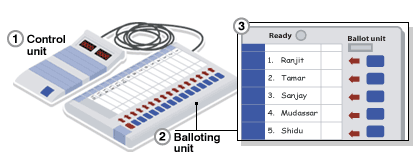Electronic Voting Machines - Blank vote option
Electronic Voting Machines - Blank vote option
Facilitator - Sara Staino , November 15. 2006Original question:
Next week our Election Commission will participate to Parliamentary Hearing to decide on the introduction of electronic voting machines based on the Indian model. With these machines there is no possibility of an invalid or blank vote as a choice for the voter.
We would urgently like to know your opinion on whether we should include in the machines a blank vote option.
1. Is a blank vote a voter’s right?
2. Do protest votes play an important function?
3. Shall we include a "none of the above" - i.e. a blank vote option - as a choice in the machines?
4. How have other countries having electronic voting systems dealt with such an issue?
Responses were received, with thanks, from:
-
Nadja Braun
-
Horacio Boneo
- Michael Maley
- Ron Gould
-
Vijay Patidar
Summary:
Blank votes may be cast for several different reasons. In many cases it is argued that blank votes are cast by voters who are unhappy with the election or with the system itself, or by voters who are truly indifferent to the options available because of lack of knowledge or because none of the options match the preferences of the voter.
Blank votes are votes with no mark, or votes with a specific "none of the above (NOTA)" mark, depending on the ballot structure and the way in which electronic voting machines are set up.
As most electronic voting machines treat not voting for any of the candidates as a blank vote, when electronic voting machines are used the usefulness of including a NOTA option is to allow the voters and those counting and reporting to differentiate between a blank vote cast by ignorance and a purposeful blank vote. However, this can also be done by including a second step, informing the voter that he/she is about to cast a blank vote and asking if he/she wants to change that decision.
The risks of introducing NOTA as an explicit option could be that it encourages cynicism and indifference among voters who feel that the NOTA is a legitimate option to a greater extent than they would had it not been there.
Not including it could encourage people to learn more about the options available and make a choice between the candidates/parties. Whether or not it is politically useful to include a NOTA option has to be decided from case to case. In the cases where many voters want to cast protest votes, a NOTA option could be useful. However - ironically enough - in these very cases the politicians are likely to be reluctant to allow this option. In cases where the NOTA option is available for voters voting on paper ballots, it is advisable to allow this option for those using EVMs as well in order not to confuse or discriminate against any group of voters.
It is also important to determine how the blank votes should be treated (counted, reported and used in determining the allocation of seats); as this can have rather significant effects. Treating blank votes as invalid is one option; another one is to report blank votes separatly from invalid ones but leaving them out when it comes to the allocation of seats; and counting them as valid votes effectively changing the support for the other candidates/parties is yet another.
As the effects are largely political, these decisions, together with the very decision to introduce or remove the NOTA option are inherently political rather than administrative and should thus be discussed by legislators.
Links to the ACE Encyclopaedia and other related resources:
- ACE Encyclopaedia: Election Nullification
- ACE Encyclopaedia: Technology for Voting Operations
- ACE Encyclopaedia: "Focus On ... E-Voting"
- Indian Electronic Voting Machine (EVM)
- BBC News: Gearing up for India's electronic election
- Indian Elections - The Electronic Voting Machine
- Council of Europe - legal, operational and technical standards for e-voting
- Countries with e-voting projects
Quote from the ACE Encyclopaedia on election nullification:
"... All the cases already mentioned are different from the case of unmarked ballots, which is known as the so-called blank vote. Such a difference might be relevant in those systems that oblige political parties to reach certain threshold to keep their registry, to access proportional representation, or to be entitled to receive public funds.
 Even though in many countries voting sites have the sole power to evaluate and nullify an individual vote, without any restriction whatsoever, in some cases votes can be appealed when there is a serious doubt on the voter’s legitimacy and identity. Such appeals are solved by superior agencies (Argentina and Uruguay).
Even though in many countries voting sites have the sole power to evaluate and nullify an individual vote, without any restriction whatsoever, in some cases votes can be appealed when there is a serious doubt on the voter’s legitimacy and identity. Such appeals are solved by superior agencies (Argentina and Uruguay).
The nullification of individual votes refers to the votes issued by individual voters, and affect neither the rest of the votes received at the affected voting site, nor the general result obtained at that particular voting point. However, some electoral laws link a significant number of nullified votes to a potential election’s nullification. Such is the case when more nullified votes than valid ones are found at a voting site (El Salvador), when nullified votes represent more than half of a particular election (Brazil and El Salvador), or when two thirds of the votes received are either nullified or blank votes (Peru)".
Individual responses in full:
Nadja Braun:
Switzerland has options for blank votes with e-voting, since blank votes are taken into account when it comes to voter turnout.
I think the answer is quite simple: wherever a blank vote is a possibility in a country, then it has to be offered with e-voting as well.
Vice versa - e-voting should not offer a possibility (i.e. blank vote) that the traditional way of casting a ballot does not offer.
All voters should be treated equally.
Horacio Boneo:
I fully agree with Nadia's comment. I just would like to add a specific comment. Almost all the machines I know about allow a blank vote (or undervote, as it is the name in the US jargon). Most of them will inform the voter that s/he is issuing a blank/under vote and ask s/he to ratify the decision to avoid blank votes being issued by mistake.
When voting with paper ballots, the inclusion of a box "None of the above" allows to differentiate between blank ballots cast by ignorance or mistake from "purposeful" blank ballots, in the sense that the person does not want to vote for any of the available candidates. It is because there is that difference that the inclusion of a specific box "None of the above" makes sense in paper based systems.
In the world of machines, if the machine requires a ratification in the case of a blank/under vote, this is the equivalent of including an specific box. The voter has opted by a blank vote after being informed that s/he might be incriing in error. I think that the addition of a specific "none of the above" makes sense in the world of machines only if the machine does not inform the voter in case of blank/under votes.
Michael Maley:
To add a few quick comments to the mix. My colleague Kevin Bodel has made the point that if machines are to be configured in this way, it would be necessary to specify in the law what will be the consequences if (a) "None of the Above" (NOTA) wins an absolute majority (eg NOTA 60%, Party A 25%, Party B 15%); or (b) NOTA wins a plurality but less than 50% (eg NOTA 40%, Party A 35%, Party B 25%). (It has the potential to get messier in preferential and proportional systems (for example, if there are 10 vacancies and NOTA wins a quota, should the number of vacancies to be filled by live candidates drop to 9?), but I won't worry about that at the moment.)
 It seems to me that whether or not providing voting for NOTA would be a good thing will vary from case to case. It will be most justified in situations where the people are genuinely badly served by all of their politicians, and where voting is in effect a sham, or bordering on it - but those are exactly the sorts of cases in which the elites would have too much sense to introduce it.
It seems to me that whether or not providing voting for NOTA would be a good thing will vary from case to case. It will be most justified in situations where the people are genuinely badly served by all of their politicians, and where voting is in effect a sham, or bordering on it - but those are exactly the sorts of cases in which the elites would have too much sense to introduce it.
In more democratic systems its effects would be more problematical. My personal view is that the system should encourage (though not necessarily compel) people to exercise their power to choose. There will always be some people who are genuinely indifferent between the candidates (and they will normally have the option of abstaining), or who feel strongly about lodging a protest vote; but I think that offering NOTA as an explicit option might encourage some people to make a rather glib statement (cynicism being much admired in some circles), when they are not really indifferent between the remaining candidates. I'm not sure that anyone would really be better off for that.
Ron Gould:
Let me add a couple of comments to Horatio, and Michael's and others' input.
I just returned from observing the US election. In Florida, the ballot not only involved elections for President, Senate and Congress, but also for multiple local offices and for local initiatives. In this kind of situation where would one draw the line on "none of the above" and what would be the criteria for inclusion or exclusion of this option???
Personally I favour the inclusion of the option but choosing it would result in a rejected ballot in order to avoid the complications described. The rejected ballots would then be subdivided into none of the above ballots, and ballots rejected for other reasons.
Vijay Patidar:
Though the Indian Electronic Voting machines (EVMs) can be programmed to record “NOTA” option (apropos Michael), the reason it is not so recorded lies in the experience of the past.
In the FPTP system of India, contest at the provincial level could be quite close. Many times the difference between the winning candidate and the trailing candidate is less then the total invalid votes.
In the Indian type of EVM at present there is no scope for an invalid or void vote. But if “NOTA” option were to be introduced, then a large number of those Indian voters who are illiterate, might mistaken it for some candidate and thus cast vote which will essentially be an invalid vote. Moreover, in the absence of a legal provision, a voter can not exercise the NOTA option.
Thus, in countries where there is no option available at present to exercise this option, there it may not be advisable to introduce this option. Similarly where this option already exists then configuring machines to record NOTA should present no problem.
By the way, in India, instead of NOTA option, to show their dissatisfaction and angst with politicians, sometimes all the voters from certain village decide to boycott the elections: a collective exercise of NOTA option!!!
The opinions expressed by members of the ACE Practitioners' Network do not necessarily reflect those of the ACE Partner organizations.

